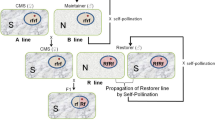Summary
A detailed description of in planta floral ontogeny based on scanning electron microscopy, developmental histology and morphology is presented for three different alloplasmic gene-cytoplasmic male-sterile (CMS)Nicotiana tabacum isonuclear lines with cytoplasms ofN. bigelovii, N. debneyi and N. suaveolens and compared to the corresponding nuclear donorN. tabacum genotype. This allowed the precise determination of the developmental stages affected in the mutant forms as well as a thorough phenotypic characterization of them. The organization of the mitochondrial genome and expression of mitochondrial DNA (mtDNA) was investigated in the three different alloplasmic CMS tobacco analogs and compared to the corresponding malefertile parentalNicotiana species. Southern hybridizations of total cellular DNA and mtDNA from the different sets of lines with probes specific for mitochondrial genes coding for cytochrome oxidase subunits I, II and III, apocytochrome b, ATPase subunits α and 9 as well as 18S-5S ribosomal RNA indicated that: (a) mtDNA organization is different between mitochondrial genomes of fertile and sterile lines but identical in two different fertile tobacco lines; however genetic similarity among different mitochondrial genome types can be revealed by restriction fragment patterns; (b) although several differences were detected between the male-sterile and male-fertile plants, most of these were related to the origin of the mitochondria (cytoplasm donorNicotiana species); (c) identical mtDNA rearrangements — distinct to the cytoplasm donor — occur in cytoplasmic malesterile tobacco analogs bearing cytoplasm fromN. bigelovii in two differentN. tabacum nuclear backgrounds, indicating that mitochondrial genome structure inNicotiana is altered by substitution of the nuclear back-ground, since (d) inter- and intraspecific mitochondrial genome diversity among differentNicotiana species and the corresponding alloplasmic CMS tobacco analogs can be determined by hybridization with mtDNA specific probes. Analysis of in organello translation products in the three CMS-systems described confirmed the presence of variant proteins synthesized by mitochondria from CMS and male-fertileNicotiana isonuclear lines. In addition, differences due to the origin of both the nucleus and the cytoplasm, which involve changes in the presence or size of particular polypeptides, are apparent. A common feature of all three systems — including two different nuclear backgrounds — is the enhanced synthesis of a 31-kDa polypeptide in the strictly isonuclear CMS lines compared to the male-fertile tobacco. In addition, organellar gene expression was studied by Northern blot analysis of transcripts homologous to mitochondrial gene probes, revealing variant mtRNA species associated with some CMS lines.
Similar content being viewed by others
References
Aviv D, Galun E (1986) Restoration of male fertileNicotiana by fusion of protoplasts derived from two different cytoplasmic male-sterile cybrids. Plant Mol Biol 7:411–417
Boeshore ML, Hanson MR, Izhar S (1985) A variant mitochondrial DNA arrangement specific toPetunia stable sterile somatic hybrids. Plant Mol Biol 4:125–132
Boutry M, Faber AM, Charbonnier M, Briquet M (1984) Micro-analysis of plant mitochondrial protein synthesis products. Plant Mol Biol 3:445–452
De Paepe R, Chetrit P, Vitart V, Ambard-Bretteville F, Prat D, Vedel F (1990) Several nuclear genes control both male sterility and mitochondrial proteins synthesis inNicotiana sylvestris protoclones. Mol Gen Genet 222:206–210
Feinberg AP, Vogelstein B (1983) A technique for radiolabelling DNA restriction endonuclease fragments to high specific activity. Anal Biochem 132:6–13
Gerstel DU (1980) Cytoplasmic male sterility inNicotiana. N C Res Tech Bull 263
Hakansson G, van der Mark F, Bonnett H, Glimelius K (1988) Variant mitochondrial protein and DNA patterns associated with cytoplasmic male-sterile lines inNicotiana. Theor Appl Genet 76:431–437
Hanson MR, Conde IF (1985) Functioning and variation of cytoplasmic genomes: lessons from cytoplasmic-nuclear interactions affecting male fertility in plants. Int Rev Cytol 94:213–267
Hanson MR, Boeshore ML, McClean PE, O'Connell MA, Nivison HT (1986) The isolation of mitochondria and mitochondrial DNA. Methods Enzymol 118:437–453
Hicks GS, Bell J, Sand SA (1977) A developmental study of stamens in a male sterile tobacco hybrid. Can J Bot 55:2234–2244
Kofer W, Glimelius K, Bonnett HT (1990) Modifications of floral development in tobacco induced by fusion of protoplasts of different male sterile cultivars. Theor Appl Genet 79:97–102
Levings CS, Brown GG (1989) Molecular biology of plant mitochondria. Cell 56:171–179
Lichtenstein C, Draper J (1985) Genetic engineering of plants. In: Glover DM (ed) DNA cloning, vol II. IRL Press, Oxford Washington, pp 67–119
Maliga P, Breznovits A, Marton L (1973) Streptomycin resistant plants from callus cultures of haploid tobacco. Nature 244:29–30
McMaster GK, Carmichael CG (1977) Analysis of singleand double-stranded nucleic acids on polyacrylamide and agarose gels by using glyoxal and acridine orange. Proc Natl Acad Sci USA 74:4835–4838
Newton KJ (1988) Plant mitochondrial genomes: organization, expression and variation. Annu Rev Plant Physiol Plant Mol Biol 39:503–532
Pring DR, Lonsdale DM (1985) Molecular biology of higher plant mitochondrial DNA. Int Rev Cytol 97:1–46
Rosenberg SM, Bonnett HT (1983) Floral organogenesis inNicotiana tabacum a comparison of two cytoplasmic male-sterile cultivars with a male fertile cultivar. Am J Bot 70:266–275
Sambrook J, Fritsch EF, Maniatis T (1989) Molecular cloning — a laboratory manual, 2nd ed. Cold Spring Harbor Laboratory Press, Cold Spring Harbor, N.Y.
Spangenberg G, Osusky M, Oliveira MM, Freydl E, Nagel J, Pais MS, Potrykus I (1990) Somatic hybridization by microfusion of defined protoplast pairs inNicotiana: morphological, genetic, and molecular characterization. Theor Appl Genet 80:577–587
Spangenberg G, Freydl E, Osusky M, Nagel J, Potrykus I (1991) Organelle transfer by microfusion of defined protoplast-cytoplast pairs. Theor Appl Genet 81:477–486
Stern DB, Newton KJ (1986) Isolation of plant mitochondrial RNA. Methods Enzymol 118:395–405
Author information
Authors and Affiliations
Rights and permissions
About this article
Cite this article
Spangenberg, G., Pérez Vicente, R., Oliveira, M.M. et al. CMS system inNicotiana: flower development, patterns of mitochondrial DNA and mitochondrial gene expression. Sexual Plant Reprod 5, 13–26 (1992). https://doi.org/10.1007/BF00714554
Issue Date:
DOI: https://doi.org/10.1007/BF00714554




